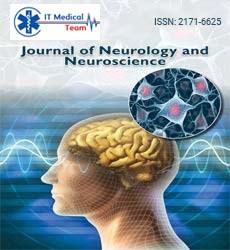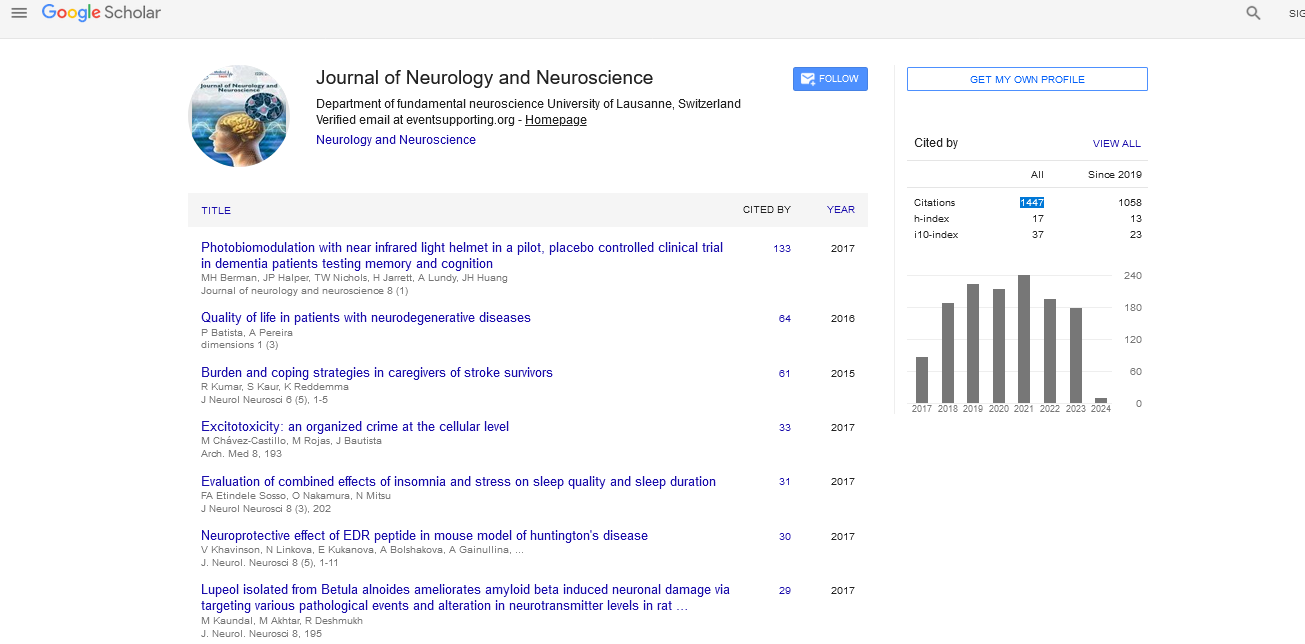Perspective - (2024) Volume 15, Issue 5
Therapeutic potential of targeting synaptic plasticity in neurodegenerative diseases
Michael Fortunato*
Department of Neurology, Westchester Medical Center, Valhalla, NY 10595, USA
*Correspondence:
Michael Fortunato, Department of Neurology, Westchester Medical Center, Valhalla, NY 10595,
USA,
Email:
Received: 03-Oct-2024, Manuscript No. ipjnn-24-15394;
Editor assigned: 05-Oct-2024, Pre QC No. P-15394;
Reviewed: 18-Oct-2024, QC No. Q-15394;
Revised: 24-Oct-2024, Manuscript No. R-15394;
Published:
31-Oct-2024
Introduction
Neurodegenerative Diseases (NDs) such as Alzheimer's
disease, Parkinson's disease, and Huntington's disease
are characterized by the progressive degeneration of the
structure and function of the nervous system. A hallmark
of these diseases is the impairment of synaptic plasticity,
the ability of synapses to strengthen or weaken over
time, which is crucial for learning, memory, and overall
cognitive function. Understanding and potentially
modulating synaptic plasticity offers a promising avenue
for therapeutic interventions aimed at halting or reversing
the progression of neurodegenerative diseases. Synaptic
plasticity is primarily classified into two forms: Long-Term
Potentiation (LTP) and Long-Term Depression (LTD).
LTP refers to the strengthening of synapses based on recent
patterns of activity, while LTD involves the weakening of
synapses. Both mechanisms are essential for learning and
memory, occurring at various synapses throughout the
brain [1].
The processes are largely mediated by neurotransmitter
systems, particularly glutamate, and involve intricate
signaling cascades that lead to changes in synaptic structure
and function. Calcium Signaling: Calcium ions (Ca²⁺)
play a crucial role in triggering the signaling pathways
that lead to LTP or LTD. The concentration and timing
of Ca²⁺ influx into the postsynaptic neuron are pivotal in
determining the outcome of synaptic activity. Glutamate
Receptors: The activation of N-methyl-D-aspartate
(NMDA) receptors is critical for LTP, while α-amino-
3-hydroxy-5-methyl-4-isoxazolepropionic acid (AMPA)
receptors mediate synaptic transmission. The recruitment
and phosphorylation of these receptors influence synaptic
strength. Gene Expression: LTP and LTD can lead to
changes in gene expression that promote the synthesis of
proteins necessary for structural changes at the synapse.
Immediate early genes (IEGs) such as c-Fos and Arc are
essential for these processes. Structural Changes: Over
time, LTP and LTD can result in the growth of new
dendritic spines or the retraction of existing ones, thereby
altering the synaptic landscape and the connectivity within
neural circuits [2].
In many neurodegenerative diseases, synaptic plasticity
is compromised, leading to cognitive decline and functional
impairments. Understanding the dysregulation of synaptic
plasticity in these diseases is crucial for developing targeted
therapies. Alzheimer's Disease (AD) is marked by the
accumulation of amyloid-beta plaques and tau tangles,
which disrupt synaptic function. Studies have shown that amyloid-beta directly affects NMDA receptor-mediated
signaling, impairing LTP and facilitating LTD. The
result is synaptic loss, which correlates with cognitive
decline in AD patients. Therapies that can restore synaptic
plasticity, such as NMDA receptor modulators or agents
that enhance Ca²⁺ signaling, hold potential in reversing
cognitive deficits [3].
Description
In Parkinson's Disease (PD), dopaminergic neurons
in the substantia nigra degenerate, leading to motor and
cognitive impairments. The loss of dopamine alters synaptic
plasticity in striatal circuits. Enhancing dopaminergic
signaling through pharmacological agents or deep brain
stimulation has been shown to improve synaptic plasticity
and may restore some cognitive functions. Research into
synaptic plasticity modulation in PD continues to explore
how to enhance dopaminergic signaling effectively.
Huntington's Disease (HD) is characterized by the
degeneration of medium spiny neurons in the striatum.
Synaptic plasticity in HD is altered, with impaired LTP
and enhanced LTD observed. This imbalance contributes
to motor dysfunction and cognitive decline. Potential
therapies include the use of gene therapy to restore the
expression of proteins involved in LTP or pharmacological
agents that can enhance synaptic transmission in affected
regions [4].
Given the pivotal role of synaptic plasticity in
neurodegenerative diseases, various therapeutic strategies
are being explored to target these pathways: Compounds
that modulate NMDA receptor activity can enhance
synaptic plasticity. For instance, memantine is an NMDA
antagonist that has been used in AD treatment, though
its ability to restore plasticity is still under investigation.
In PD, dopamine agonists such as pramipexole can
enhance synaptic plasticity in the striatum, improving
motor functions and potentially cognitive symptoms.
Brain-derived Neurotrophic Factor (BDNF) is essential
for promoting LTP. Therapies that increase BDNF levels
or mimic its action may help restore synaptic function.
Research is ongoing to develop small molecules that can
enhance BDNF signaling [5].
Cognitive Training and Rehabilitation: Behavioral
therapies aimed at enhancing cognitive functions can
stimulate synaptic plasticity. These interventions may lead
to structural changes in the brain, promoting resilience
against neurodegenerative processes. Physical activity
has been shown to enhance BDNF levels and improve
synaptic plasticity. Regular exercise may offer a protective
effect against the onset of neurodegenerative diseases
and could be a valuable adjunct to pharmacological
treatments. Advancements in gene therapy present
exciting opportunities to directly target synaptic plasticity
mechanisms. Techniques such as CRISPR/Cas9 allow
for the precise editing of genes involved in synaptic
function. Research is underway to develop gene therapies
that can correct deficits in synaptic proteins or enhance
the expression of plasticity-related genes. Identifying
biomarkers associated with synaptic plasticity changes can
aid in the development of targeted therapies. For instance,
measuring levels of synaptic proteins or neurotrophic
factors in cerebrospinal fluid could provide insights into
the state of synaptic plasticity in patients, allowing for
personalized treatment approaches.
The complex interplay between different
neurodegenerative processes and synaptic plasticity needs
to be better understood. Research must continue to
elucidate the mechanisms underlying synaptic dysfunction
in specific diseases. Many pharmacological agents that
enhance synaptic plasticity may have side effects or lead to
adverse outcomes. Rigorous clinical trials are necessary to
establish the safety and efficacy of new therapies. Genetic
and environmental factors can influence synaptic plasticity
and responses to therapies. Developing personalized
approaches based on individual patient profiles may
enhance treatment outcomes. The long-term impacts of
therapies targeting synaptic plasticity are still uncertain.
Continuous monitoring and assessment will be essential to
understand the sustainability of therapeutic benefits.
As research advances, the concept of personalized
medicine becomes increasingly relevant in the context
of synaptic plasticity. Individual differences in genetic
makeup, environmental influences, and disease pathology
necessitate tailored therapeutic approaches. Understanding
genetic factors that influence synaptic plasticity can help
identify patients who may benefit most from specific
interventions. For instance, variations in genes related to
BDNF signaling, neurotransmitter receptors, or calcium
channels may affect an individual’s response to therapies
targeting synaptic plasticity. Pharmacogenomic approaches
can guide the selection of medications based on an
individual’s genetic profile. This precision medicine strategy
can enhance treatment efficacy and reduce adverse effects,
ultimately leading to better outcomes for patients. The
identification of biomarkers that reflect synaptic plasticity
changes could facilitate early diagnosis and tracking of
disease progression. Biomarkers may also serve as indicators
for the effectiveness of therapeutic interventions, allowing
for more dynamic and responsive treatment strategies.
Conclusion
Targeting synaptic plasticity presents a promising
strategy for the treatment of neurodegenerative diseases.
By restoring the balance of synaptic strength, therapies
aimed at enhancing LTP and inhibiting LTD could
mitigate cognitive decline and improve functional
outcomes for patients. As research advances, the potential
for innovative pharmacological, non-pharmacological,
and gene therapies continues to grow, paving the way
for more effective interventions in the battle against
neurodegenerative diseases. Continued exploration into
the mechanisms of synaptic plasticity will be crucial for
realizing the full therapeutic potential of these approaches,
ultimately leading to improved quality of life for those
affected by these debilitating conditions. By fostering a
collaborative approach that combines basic science with clinical applications, we can unlock new avenues for
intervention in the realm of neurodegenerative diseases,
ultimately improving the lives of millions affected by these
conditions. The therapeutic targeting of synaptic plasticity
not only holds promise for restoring cognitive function
but also offers hope for a future where neurodegenerative
diseases can be effectively managed or even prevented.
Acknowledgement
None.
Conflict of Interest
None.
References
- Ferreira JV, da Rosa Soares A, Ramalho J, et al. LAMP2A regulates the loading of proteins into exosomes. Sci adv. 2022; 8(12):eabm1140.
Google Scholar, Crossref, Indexed at
- Kutas M. Federmeier K. Thirty Years and Counting: Finding Meaning in the N400 Component of the Event-Related Brain Potential (ERP).Annu Rev Psychol.2011;62(1):621-647.
Google Scholar, Crossref, Indexed at
- Henne WM, Buchkovich NJ, Emr SD. The ESCRT pathway. Dev Cell. 2011; 21(1):77-91.
Google Scholar, Crossref, Indexed at
- Klumperman J, Raposo G. The complex ultrastructure of the endolysosomal system.Cold Spring Harb Perspect Biol. 2014; 6(10):a016857.
Google Scholar, Crossref, Indexed at
- Stuffers S. Sem Wegner C. Stenmark, H. et al. Multivesicular endosome biogenesis in the absence of ESCRTs.Traffic.2009; 10(7):925-937.
Google Scholar, Crossref, Indexed at





